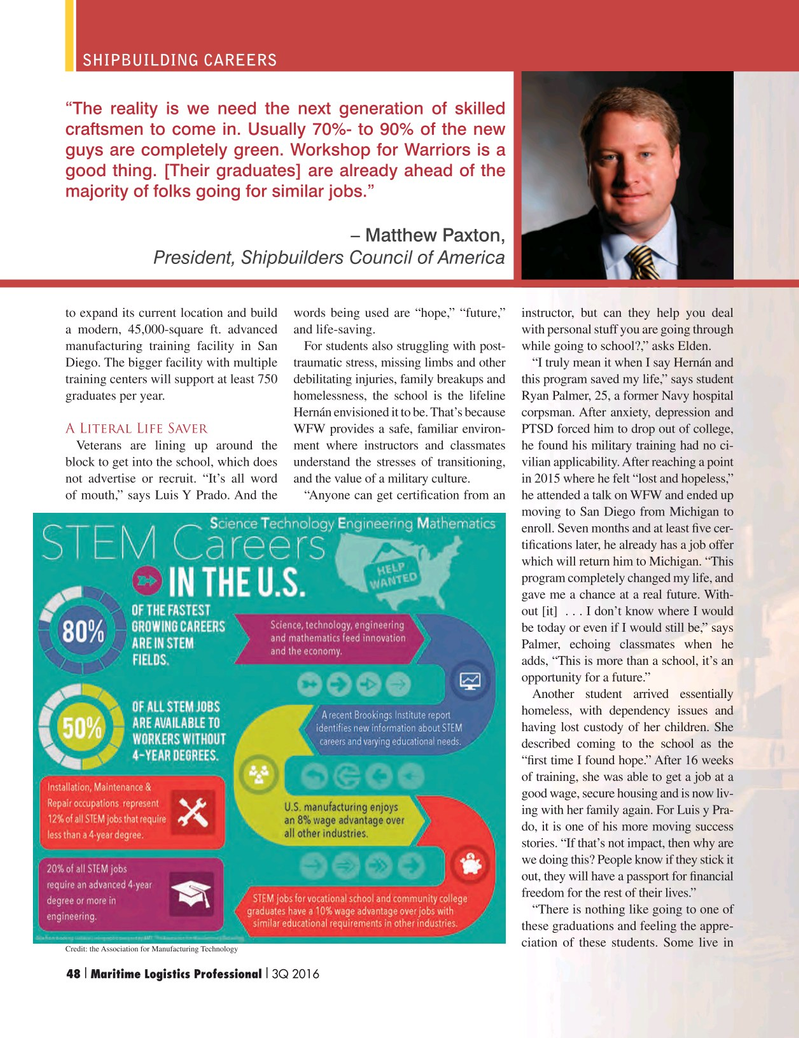
Page 48: of Maritime Logistics Professional Magazine (Q3 2016)
Shipbuilding, Repair & Maintenance
Read this page in Pdf, Flash or Html5 edition of Q3 2016 Maritime Logistics Professional Magazine
SHIPBUILDING CAREERS “The reality is we need the next generation of skilled craftsmen to come in. Usually 70%- to 90% of the new guys are completely green. Workshop for Warriors is a good thing. [Their graduates] are already ahead of the majority of folks going for similar jobs.” – Matthew Paxton,
President, Shipbuilders Council of America to expand its current location and build words being used are “hope,” “future,” instructor, but can they help you deal a modern, 45,000-square ft. advanced and life-saving. with personal stuff you are going through manufacturing training facility in San For students also struggling with post- while going to school?,” asks Elden.
Diego. The bigger facility with multiple traumatic stress, missing limbs and other “I truly mean it when I say Hernán and training centers will support at least 750 debilitating injuries, family breakups and this program saved my life,” says student graduates per year. homelessness, the school is the lifeline Ryan Palmer, 25, a former Navy hospital Hernán envisioned it to be. That’s because corpsman. After anxiety, depression and
A Literal Life Saver WFW provides a safe, familiar environ- PTSD forced him to drop out of college,
Veterans are lining up around the ment where instructors and classmates he found his military training had no ci- block to get into the school, which does understand the stresses of transitioning, vilian applicability. After reaching a point not advertise or recruit. “It’s all word and the value of a military culture. in 2015 where he felt “lost and hopeless,” of mouth,” says Luis Y Prado. And the “Anyone can get certi? cation from an he attended a talk on WFW and ended up moving to San Diego from Michigan to enroll. Seven months and at least ? ve cer- ti? cations later, he already has a job offer which will return him to Michigan. “This program completely changed my life, and gave me a chance at a real future. With- out [it] . . . I don’t know where I would be today or even if I would still be,” says
Palmer, echoing classmates when he adds, “This is more than a school, it’s an opportunity for a future.”
Another student arrived essentially homeless, with dependency issues and having lost custody of her children. She described coming to the school as the “? rst time I found hope.” After 16 weeks of training, she was able to get a job at a good wage, secure housing and is now liv- ing with her family again. For Luis y Pra- do, it is one of his more moving success stories. “If that’s not impact, then why are we doing this? People know if they stick it out, they will have a passport for ? nancial freedom for the rest of their lives.” “There is nothing like going to one of these graduations and feeling the appre- ciation of these students. Some live in
Credit: the Association for Manufacturing Technology 48 Maritime Logistics Professional 3Q 2016I I 34-49 Q3 MP2016.indd 48 8/17/2016 10:43:38 AM

 47
47

 49
49
